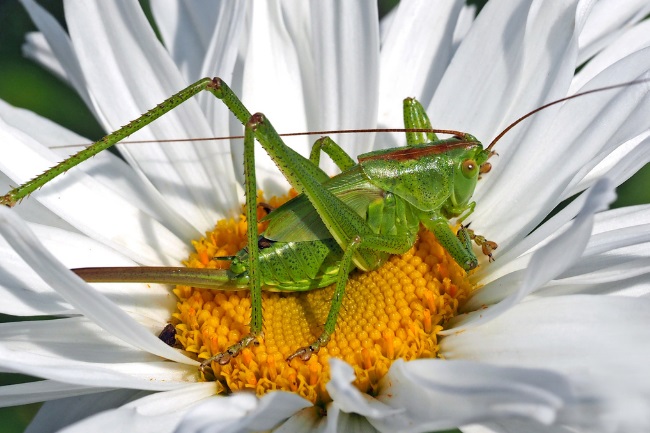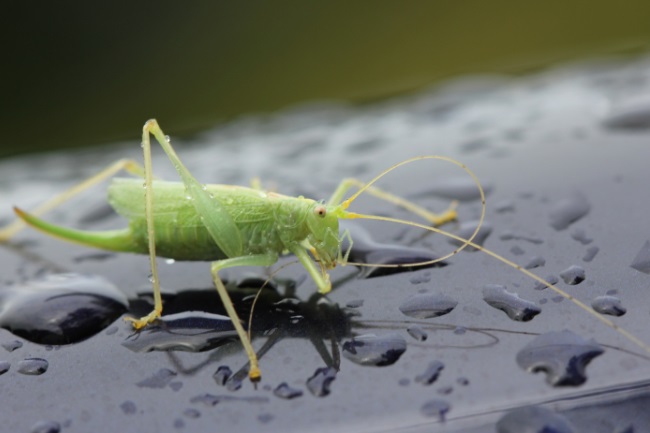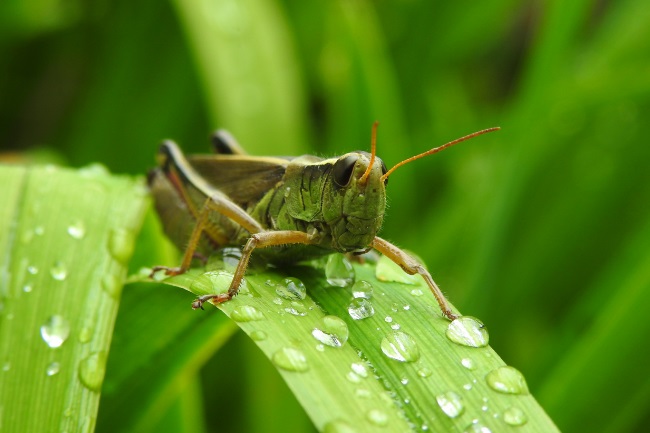Grasshoppers generally don’t drink in the same way that mammals do, getting the moisture they need from the plant matter they eat. It is, however, possible for them to drink, and they will sometimes take advantage of raindrops on leaves or condensed moisture to take a sip.
Contents
Do grasshoppers drink?

Like many insects, grasshoppers do not drink in the same way we do. This is largely down to their diet. The majority of grasshoppers are herbivores, eating a large variety of plant matter. Because plants are so high in water, this gives the grasshopper enough moisture without needing a separate glass of water to wash it down.
| Substance | Description |
|---|---|
| Water | Primary source of hydration for grasshoppers |
| Plant Sap | Sugary fluids extracted from plant tissues |
| Dew | Moisture collected from the surfaces of plants |
| Rainwater | Water collected from rainfall |
This isn’t to say that grasshoppers won’t occasionally slurp up the odd raindrop. While they get enough moisture from their food in general, they can occasionally take advantage of the water surrounding them. All insects struggle with desiccation, mainly through water lost when they breathe or through their skin. On a sunny day, a leaf’s surface can get pretty hot, meaning it’s not such a bad thing to get a little extra hydration.
Additionally, some grasshoppers will eat an omnivore diet at times, munching down on the odd bit of meat or animal waste. Grasshoppers aren’t particularly adapted to hunt, so the majority of what they eat that isn’t a stationary plant will be an insect that’s already long dead. This openness to other food sources can be beneficial to grasshoppers living in desert environments, where new plant matter might be rare. The plains lubber grasshopper, for example, has been found even to take advantage of abandoned spider webs to fill its empty stomach. Grasshoppers that eat these drier foods are more likely to need to take on additional water.
The most devastating of the grasshopper family is the locust. Although we often think of locusts as an entirely different species, they are grasshoppers that have undergone specific changes as the density of other grasshoppers around them has risen. Undoubtedly worthy of their reputation as a plague, these swarms can decimate crops as they pass through, eating everything in their sight. Yet even these monsters feel no need to stop off and get a cup of water.
How do grasshoppers utilise water?
Like many insects, grasshoppers try hard to lose as little water as they can, their bodies designed to keep hold of it. This includes closing the spiracles that they use to pump air around their bodies. As the air leaves, it takes moisture from where it has been in contact with the insect’s warm body. Some scientists disagree that this theory holds much water though, arguing the rate of loss to be insignificant.

Another way that grasshoppers avoid losing extra water is by having solid waste. A grasshopper’s faeces is generally a hard brown oblong, similar in size to a grain of rice. They don’t produce separate urine as they remove excess water and excrete the nitrogenous waste within their faeces. This prevents them from losing precious water.
| Habit | Description |
|---|---|
| Active Drinking | Actively seeking out water sources and drinking |
| Passive Absorption | Absorbing moisture through body surfaces, like their legs |
| Plant Feeding | Consuming plant sap, which provides hydration |
| Water Sources | Preferred water sources, such as puddles or moist plants |
Like most animals, grasshoppers produce saliva. Essentially this is to help lubricate the journey of its food from the mouth into the crop. However, as well as saliva, grasshoppers produce a brown liquid that is often known as ‘tobacco juice’. This liquid it different from saliva, being made up of the regurgitated contents of the insect’s stomach, including half-digested leaf matter and stomach enzymes.
Insects like grasshoppers and katydids vomit up tobacco juice when they are feeling threatened. This nasty tasting liquid is perhaps supposed to put off predators by trying to convince them that the grasshopper itself is not worth eating.
What do baby grasshoppers drink?
Baby grasshoppers are called nymphs. Unusual for the young of an insect, they do not take a completely different form from the adult; instead, a grasshopper nymph looks just like the adult but a lot smaller. Like the adult grasshoppers, these nymphs spend most of their time eating tasty vegetation. However, as they are so tiny, these mouthparts aren’t strong enough to eat some of the parts of the plants that the adults would eat. Therefore they are primarily focusing on fresh shoots and seedlings.
As their diet is mainly herbivorous, like their parents, they too will get the majority of their water from the plant matter they eat. Not to say they won’t sometimes try their hand at something else. Some studies have show species can become cannibalistic when they encounter another grasshopper that has moulted and is therefore weak and easy prey on.
Should I give my pet grasshopper water?

Many people enjoy keeping grasshoppers as pets or rear them as live food to feed to reptiles or amphibians. With most pets, we’re used to filling a bowl full of water as well as putting out some tasty snacks, but with grasshoppers, it’s simply not necessary.
Feeding your grasshopper on a diet of fresh grass, leftover vegetables, or other vegetation will mean that they have plenty of water to be getting on with. Some owners occasionally spray the foliage before putting it into the cage, which can make up for the plant matter wilting, as it’s not attached to a functioning root system.
A nice cup of tea
So the answer is that grasshoppers largely don’t drink, simply imbibing the water from the plant vegetation they eat. Like many insects, they will occasionally drink from handy water when they’ve got a thirst on.

